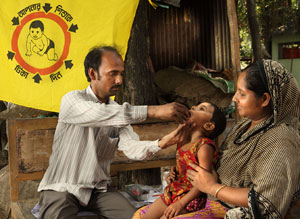Field Stories
Go door-to-door to deliver vitamin A supplementation in remote areas in Bangladesh
September 24, 2024
WP_Term Object
(
[term_id] => 49
[name] => Field Stories
[slug] => all-field-stories
[term_group] => 0
[term_taxonomy_id] => 49
[taxonomy] => news-category
[description] => Discover the personal stories of people whose lives have been impacted by better nutrition, and those working tirelessly to deliver it.
[parent] => 0
[count] => 180
[filter] => raw
)
Reaching the hard-to-reach in Bangladesh with vitamin A
While vitamin A coverage is high in Bangladesh, in many areas with over 90 per cent coverage with two doses, some children are still being missed.
Posted on February 15, 2012
 The physical geography of Bangladesh has two distinctive features: the hill tracts of Chittagong, criss-crossed by multiple rivers, and the deltaic Bangladesh Plain, prone to frequent flooding.
The physical geography of Bangladesh has two distinctive features: the hill tracts of Chittagong, criss-crossed by multiple rivers, and the deltaic Bangladesh Plain, prone to frequent flooding.
Thousands of tiny villages and hamlets dot the landscape, separated from other communities by mighty rivers, their tributaries, woodlands or high hills.
Many remain isolated for months at a time by floodwaters. Because of their isolation and the challenges of travelling, these villages often have little opportunity to be represented at local or district elections and don’t have access to many services.
While vitamin A coverage is high in Bangladesh, in many areas with over 90 per cent coverage with two doses, some children are still being missed; their communities are far from the nearest health centre, health workers seldom visit and there are not enough children in the individual locations to warrant a separate vaccination centre. Considered “hard-to-reach”, the lack of health services puts children at higher risk of mortality.
In 2008, MI embarked on a campaign with local NGOs who work in hard-to-reach areas to significantly increase the number of children who received health interventions such as vitamin A.
A key feature of this program is the active involvement of community groups, who conduct monitoring and are responsible for mobilization of families with unreached children. MI helped prioritize low-performing districts, sub-districts and unions (the lowest administrative units) to identify those children most at risk.
Each union was divided into three wards and Special Volunteers were assigned to each ward. The Special Volunteers identify hard-to-reach children in their villages, work with others to identify children in nearby villages and sometimes conduct door-to-door searches. They mobilize communities and make special announcements in local languages to promote health services; they may also bring children to outreach centers where they receive vitamin A.
In 2010, more than 420,000 hard-to-reach children received two doses of vitamin A.
MI is now working with the Government of Bangladesh to include this supplementary distribution program as an integral component of its larger vitamin A supplementation program and so reach more of the country’s hard-to-reach children.